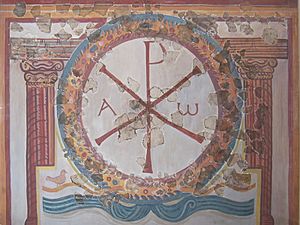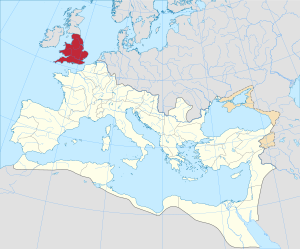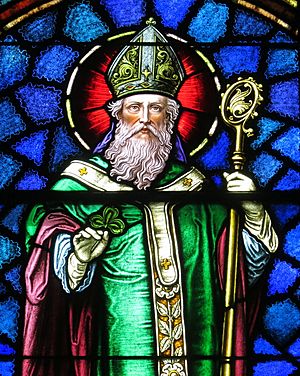Christianity in Roman Britain facts for kids
Christianity was present in Roman Britain for a long time. It arrived by at least the 200s AD and stayed until the Roman Empire left Britain in the early 400s. It then continued in western Britain.
Religion in Roman Britain usually involved believing in many gods and goddesses. This is called polytheism. Christianity was different because it believed in only one God. This is called monotheism. Christianity was one of several religions that came to Britain from the eastern parts of the Roman Empire. Other religions included those dedicated to gods like Cybele, Isis, and Mithras.
After the Roman Empire left, many people in southern and eastern Britain were affected by the arrival of the Anglo-Saxons. They mostly followed their own pagan religion. Later, in the 600s, the Anglo-Saxons became Christians. This happened after the Augustinian mission brought the church back to England. Writers like Bede knew that Christianity had existed in Roman Britain before. In fact, the Christian church in Wales continued without stopping.
Contents
How Christianity Came to Britain
People in Roman Britain usually worshipped many gods and goddesses. They often chose local gods as well as the main Roman gods. Sometimes, British and Roman gods were even worshipped together, like Apollo and Cunomaglus, or Sulis and Minerva. Roman-British temples were sometimes built where people had worshipped in the Iron Age before the Romans arrived. A new type of temple, called a "Romano-Celtic temple," mixed both Iron Age and Roman styles. These buildings were used until the 300s.
Christianity was just one of several new religions that came to Roman Britain from the eastern parts of the empire. Others included the worship of Isis, Mithras, and Cybele.
An archaeologist named Martin Henig suggested thinking of India today to understand how Christianity might have felt back then. In India, Hinduism (a religion with many gods) is very common. Churches with images of Christ are much rarer compared to the many temples for Hindu gods.
Christianity started from Judaism, but by the mid-100s AD, they were seen as separate religions. There is no clear proof that Judaism was practiced in Roman Britain.
Finding Evidence
It's not easy to find proof of Christianity in Roman Britain. The archaeological evidence is not very large. It can also be hard to tell if an old item was used for Christian or pagan worship. Sometimes, it's just a guess. The Christian items found make up only a tiny part of all the Roman British things archaeologists have found.
Timeline of Christianity in Britain
The Early Years (100s and 200s AD)
We don't know exactly when Christianity first arrived in Roman Britain. Many people came to Britain from all over the Roman Empire, and some of them might have been Christians. But there's a difference between a few Christians visiting and a settled Christian community living there. Some historians think Christianity might have arrived in Britain in the late 100s.
Around 200 AD, a writer named Tertullian from Carthage said that Christianity had reached Britain. Another writer, Origen, also wrote that Christianity had come to Britain. We can't be totally sure if these statements are true, because both writers often used strong words to make their illegal religion sound more important. But it's possible they were based on some truth.
Christianity grew slowly but steadily across the Roman Empire in the 200s. In the middle of that century, Christians faced more attacks and punishments, especially under Emperors Decius and Valerian. These attacks might have affected Christians in Britain. It's possible that Julius and Aaron, two British Christian martyrs mentioned in old writings, were killed around this time.
In 260 AD, Emperor Gallienus made a rule that stopped punishing Christians. This allowed the Church to own property. These changes happened while the empire was facing political problems and financial difficulties.
The Later Years (300s and 400s AD)
In 313 AD, the Emperors Constantine and Licinius issued the Edict of Milan. This stopped the punishment of Christians in the empire. Writings from this time show that the British Church was involved with the wider Christian Church across the Roman Empire.
In 314 AD, a meeting called the Council of Arles was held to discuss problems in the Christian community. A document about this meeting shows that three bishops from Britain were there. This means that by the early 300s, British Christians were organized and had their own church leaders.
British bishops also attended the Council of Ariminum in Italy. Some historians believe British bishops were at other councils too.
The names of some Roman-British bishops have also been found on old objects. For example, a broken inscription on a silver plate says, "Bishop Exuperius gave [this] to..." Another inscription on a lead salt-pan likely says, "Of Viventius, the bishop..."
By the late 300s, Christians held important jobs in the government of Britain. The Roman poet Ausonius wrote letters to Flavius Sanctus, who was a Christian governor of one of the British areas. In 391 AD, Emperor Theodosius banned all pagan religions across the empire. Christianity became the official religion. This rule would have affected Britain. Some historians think that by the end of the 300s, many people in Britain were Christian.
Several famous Christians were born in Roman Britain. Pelagius, who started a religious idea called Pelagianism, was probably born in Britain in the late 300s. However, he lived most of his life in Europe. Saint Patrick was also born in Britain to a Christian family. His book, Confessio, is the only writing we have from a Roman-British Christian. It mostly talks about his time in Ireland, not Britain.
Other old writings also mention Christianity in Britain in the late 300s and 400s. In the 390s, Victricius, a bishop from France, visited Britain and wrote about priests being there. Another French bishop, Germanus of Auxerre, was sent to Britain by Pope Celestine I in 429 AD. He went to deal with a bishop who was spreading Pelagianism. Writings about Saint Germanus say he visited Britain a second time.
By the 300s, some Roman-British families might have had members who were Christian and others who followed pagan religions. Some people might have changed their beliefs back and forth.
Christianity Continues (400s and 500s AD)
Many archaeologists believe that Roman life in Britain ended quickly in the early 400s. After this, the Anglo-Saxon migration began. People from what is now Denmark and northern Germany settled in Britain. This led to the culture we call Anglo-Saxon England. Archaeologists now think this change from Roman-British to Anglo-Saxon culture happened slowly, not as a sudden takeover.
Old writings suggest that the Christian communities in Roman Britain continued in Western Britain during the 400s, 500s, and 600s. This Western British Christianity developed on its own. In the 540s, a writer named Gildas was criticizing British bishops.
In the late 500s, the Pope sent Augustine of Canterbury on a mission to convert the Anglo-Saxons to Christianity. According to the monk Bede, Augustine's missionaries used an old Roman-British church dedicated to St Martin. They also got permission from the king of Kent to fix up several old churches. Other writings also show that Roman-British churches survived during this time.
Early Churches
In Roman Britain, a church was mainly a place where the Eucharist (a Christian ceremony) was held. It was also a meeting place, a place for group worship, and a place for private prayer.
Unlike later times, Roman Britain did not have many parish churches. Instead, there were different types of church buildings. One word for a church used in Roman Britain was altare. This word appears on an inscription from the Christian Water Newton hoard and was not usually used for pagan worship sites.
Church buildings needed an altar for the Eucharist, a place to read from the Bible, space for offerings, and room for the people worshipping. From other parts of the Roman Empire, we know that Roman-British churches probably also had a special chair for the bishop and a room where people who hadn't been baptized could wait.
Because Christians were sometimes punished for their beliefs, they couldn't always build official churches. So, early Christian meeting places often looked just like regular houses. While some of these "church houses" have been found elsewhere in the empire, none have been found in Britain yet.
It's possible that Christians might have used existing Roman-Celtic temples as their places of worship. This idea has been suggested for the temple in front of the Roman theatre at Verulamium.
Other pre-Christian religious sites might also have been used by Roman-British Christians. One example is the spring at Chedworth.
There's a long-standing story in London that St Peter upon Cornhill church was founded by King Lucius after he became Christian in 179 AD. Interestingly, the church's altar is right above where a pagan shrine room of the great Roman London basilica might have been. If King Lucius really existed, it would make sense that he turned a pagan shrine into a church.
Two other facts might support St Peter's Roman past. First, London sent a bishop named Restitutus to the Council of Arles in 314 AD. Restitutus must have had a church to lead. Second, in 1417, during a discussion about church importance, the Mayor of London confirmed that St Peter's was the first church founded in London. Since St Paul's Cathedral was founded in 604 AD, this suggests that St Peter's was believed to be founded before 600 AD.
Worship Ceremonies
Christian symbols on jugs, bowls, cups, spoons, and other items for food or drink suggest that Christians in Roman Britain had special feasts. Many of these items, like those from the Water Newton hoard, were fancy. This suggests that the Christian community might have relied on its richer members for their special ceremony items.
Some mosaic floors likely show Christian pictures.
Most Roman-British Christians probably couldn't read or write. So, most of what they knew about Christianity would have come from these ceremonies.
Martyrs and Saints
There are three known Christian martyrs from Roman Britain: Aaron, Julius, and Alban. Historians have debated when these people lived and died. The name Aaron is Hebrew, which might mean he had Jewish family.
Aaron and Julius were probably killed together in the 200s. This likely happened before the Roman soldiers left Caerleon around 290 AD.
The exact date of Alban's death is not known for sure. Alban is the only Roman-British martyr whose worship definitely continued after the Romans left. This happened among a group of British Christians. Germanus described visiting Alban's shrine and exchanging holy items there in 429 AD. There might have been other Roman-British saints whose worship continued into the 500s and 600s, but they might have been forgotten during the Anglo-Saxon migration.
|





